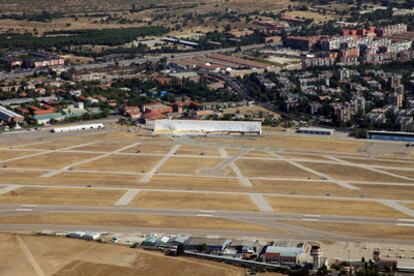The pope's Madrid set designer
Architect and Opus Dei member Ignacio Vicens has been creating strikingly minimalist stage sets for papal visits to the Spanish capital since 1982
When Ignacio Vicens was tasked with his first stage design for Pope John Paul II - for his 1982 visit to Madrid - he knew he wanted to make a break with the past. "The papal stage sets I had seen up until then had always seemed to me to be, well... how would I say it piously?" The architect purses his lips and drums his chin with his index finger, a parody of doubt. Then, smiling, he says: "Historicist."
So when it came to designing the stage for Pope John Paul at the Bernabéu soccer stadium, Vicens decided against the silver-plated altars, velvet curtains and baroque crucifixes that were the stock-in trade of papal addresses. "The key to the whole thing was making the pope more accessible, so I put him in the center of the pitch, surrounded by people," he says. Vicens' stage layout was 1980s design itself: white, with cold straight lines, and a minimalist canopy made up of four columns, reached by a red runway. "That was the only thing I would change. It turned out a bit Hollywood," he admits.
Since then, Vicens has overseen most of the stage sets for papal visits to the capital. Two popes, four visits, and six sets in all (including the two for this week's events in Cibeles and Cuatro Vientos) as well as the 200 open-air confessional boxes that he has designed for the mass pardoning to take place in the capital's Retiro park. He says one idea has always guided his work: "The Church needs to return to the vanguard." Which is why his sets, ordered along military and futuristic lines, rigorously avoid the ornamentation associated with the liturgy.
Talking to Vicens at his ultra-clean studio in central Madrid, the architect, a member of the Opus Dei movement, explains that his involvement in designing stage sets for papal visits began by coincidence. "I was asked if I wanted to design that stage set in 1982 because someone told a senior official in the clergy that my doctoral thesis was about baroque temporary architecture."
The five-volume work examined how royalty and the Church decorated the cities of the 17th century for festivals, royal weddings and victory celebrations. "That interested me because it wasn't just set design. They used pretend materials, not pretend spaces: triumphal arches seemed to be made of marble when they were made of wood, but they were still triumphal arches. The architects experimented with ideas in temporary architecture that they would later use in permanent architecture.
"I do the same," continues the architect, who, among other projects, also designed the decorations for the wedding of Prince Felipe and Princess Letizia in Madrid's Almundena cathedral. "For the first time I have decided to use curved lines in the stage at Cibeles for Benedict XVI."
For the platform at Cibeles, which faces the former post office and current home of Madrid City Hall, Vicens has created a canopy in the form of a low wave that will protect Ratzinger from the fierce Madrid summer sun. "It all looks very maritime," says Vicens, "echoing the confession boxes in the Retiro, also curved, which look a bit like windsurf sails. My aim is simply to create a space that feels young and happy," he explains. "I love it when people light up matches or their lighters during Masses, like they do at rock concerts."
Vicens says the Vatican is "an easy client" to work with. "It is more concerned with organization than esthetics." He says that during his visits to Rome to present his ideas, "they are very respectful of my creative freedom," although he suggests that some of his more radical ideas have been politely turned down.
He dismisses accusations that this week's papal visit is too costly at a time of crisis. "I can't talk about budgets, but I will say that the stage set for Cuatro Vientos, which was very cheap to build, cost nothing, because it was paid for by the OHL and FCC construction companies. It didn't cost a thing. As for the criticism from grassroots associations within the Catholic Church about the cost of the visit, all I can say to them is that we are talking here about two million people coming to Madrid."
Surrounded by his plans and designs, Vicens is clearly enthusiastic about the upcoming event: from the lights that will be projected on to the Cuatro Vientos stage "to give a little life to the vigil," to the makeover he has given the papal shield to bring it a little more into the 21st century.
He also remembers how in 1982 he convinced Juan Miguel Antoñanzas, the then-head of car manufacturer SEAT, to customize its low-budget Panda into a Popemobile, because he didn't like the look of the official vehicle the Vatican was to provide. "I wanted something young, something accessible: a Pandamobile!"








































